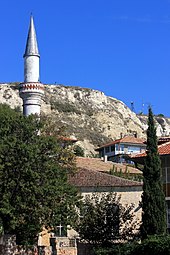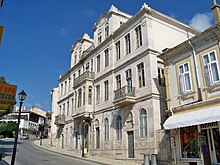Balchik
| Balchik (Балчик) | ||||
|
||||
| Basic data | ||||
|---|---|---|---|---|
| State : |
|
|||
| Oblast : | Dobrich | |||
| Residents : | 11,051 (December 31, 2018 ) | |||
| Area : | 74.41 km² | |||
| Population density | 148.5 inhabitants / km² | |||
| Coordinates : | 43 ° 24 ' N , 28 ° 10' E | |||
| Height : | 199 m | |||
| Postal code : | 9600 | |||
| Telephone code : | (+359) 0579 | |||
| License plate : | TX | |||
| administration | ||||
| Mayor : | Nikolai Dobrew Angelov | |||
| Website : | balchik.bg | |||
Balchik [ bɐɫˈtʃik ] ( Bulgarian Балчик ; other more common spellings Balchik , Balčik ) is a small port town on the Black Sea in northeastern Bulgaria in Dobrich Oblast .
geography
Balchik is located in the Dobruja region on the coast of the Black Sea. The city is located about 31 kilometers northeast of Varna . Balchik has 11,399 inhabitants (December 31, 2016) and covers an area of 74.41 km².
history
The first settlement at this point was in the 7th century BC. Founded by Ionians from Miletus and was called Krounoi (Greek Κρουνοι; German spring). Since the second half of the 3rd century BC The name of the place was Dionysopolis (Greek Διονυσόπολις) after Dionysus , the god of wine. Even later the place had the old Bulgarian name Karwuna. On Italian Portolan cards from the 14th century, Karwuna was mentioned in the Italian form Carbona. The city was mentioned in the Dubrovnik Charter in 1230 .
After the city was annexed by Bulgaria and belonged to the Dobruja despotate , the boyar Balik gave it the name Balchik. The remains of his fortress can be found above the Balchik Municipal Hospital in the Gemijia (Bulgarian Гемиджия ) district. These remains are almost completely destroyed and weathered and can hardly be seen. In the Vasil Levskii district are the remains of the Karwuna fortress, which was built by the Byzantines and used by both the Byzantines and the Bulgarians during the period of the First Bulgarian Empire in the 11th century.
After the Crimean War (1853-1856) Balchik became a center of the grain trade .
The once Turkish and Tatar majority of the population was ousted by Bulgarians and Greeks after Bulgaria's independence between 1878 and 1913, and most of the Greeks were later also expelled.
From 1913 to 1940 the city belonged to Romania, as the South Dobruja, which previously belonged to Bulgaria , was annexed by Romania (with the Peace Treaty of Bucharest ) after the Second Balkan War . After the Treaty of Craiova , Balchik became Bulgarian again.
The city has given its name to the Balchik Ridge , a mountain ridge on Livingston Island in Antarctica , since 2004 .
Culture and sights
In the city there is an ethnographic complex with a museum dedicated to the era of the so-called Bulgarian Revival .
Castle and Castle Park
The Romanian Queen Maria was enthusiastic about Balchik's location and had a small summer palace and botanical garden laid out there from 1924 . After the death of her husband, the queen is said to have expanded the palace into a love nest for a Muslim in the oriental style, as indicated by a minaret in the palace gardens. The Italian architects Amerigo and Augustino were entrusted with the construction of the summer residence. The summer residence includes the actual palace, which is surrounded by tall towers, a chapel in which, according to the Queen's will, her heart is kept, a villa that was originally intended to accommodate Romanian aristocrats and a stone throne under an old tree where the Queen Maria liked to sit to look at the sea. The summer palace is a mixture of Bulgarian, Moldavian , Moorish and Oriental architectural elements. The palace park is modeled on the winding palace of Knossos , the origin of the myth of the labyrinth of Crete from the Minotaur legend. The stones of the church in Balchik Castle come from Crete .
The castle park is named Tenha Yuva (Silent Nest). It was laid out between 1924 and 1936 according to a design by the Swiss landscape architect Jules Janine - he was the main gardener of the Russian Tsar Nicholas II until the October Revolution in Russia . The queen died in 1938, two years before the region including her summer palace was returned to Bulgaria. The castle and the garden were declared a cultural monument.
With her enthusiasm for Balchik, Queen Maria also attracted numerous visitors from the Romanian nobility and Romanian artists to the town.
Over 3000 rare plant species grow in the castle park, including over 200 different tree species. Therefore, in 1955 the palace park became a branch of the University of Sofia as a botanical garden . He has a very large cactus collection with over 250 species, which is the second largest cactus collection in Europe after the Exotic Garden of Monaco .
The Botanical Garden, which was initially neglected after 1990, has been looked after by the University of Sofia since 2004 and is an attraction for landscape architects, botanists and tourists due to its location on the sea cliff.
traffic
Balchik is on the main road that runs from Varna to Mangalia in Romania along the Black Sea coast.
The city has a small seaport , a marina and a currently unused airport ( ICAO code LB25) which is being considered for use by low-cost airlines .
Town twinning
-
 Armutalan , Turkey
Armutalan , Turkey -
 Bran , Romania
Bran , Romania -
 Mangalia , Romania
Mangalia , Romania -
 Stará Ľubovňa , Slovakia
Stará Ľubovňa , Slovakia -
 Hagfors , Sweden
Hagfors , Sweden -
 Cieszyn , Poland
Cieszyn , Poland -
 Boxberg / OL , Germany
Boxberg / OL , Germany
literature
- Karl Georg Brandis : Dionysopolis 1. In: Paulys Realencyclopädie der classischen Antiquity Science (RE). Volume IX, 1, Stuttgart 1914, Col. 1008 f.
- Manfred Oppermann : Thracians, Greeks and Romans on the west coast of the Black Sea . Zabern's illustrated books on archeology . Zabern, Mainz 2007, ISBN 978-3-8053-3739-7 .
Individual evidence
- ↑ Population by towns and sex. In: nsi.bg. Republic of Bulgaria - National Statistical Institute (NSI), April 12, 2019, accessed May 5, 2019 .
- ↑ Община Балчик. www.balchik.bg, accessed on July 27, 2019 (Bulgarian).
- ↑ Hotels in Bulgaria project surge in Russian tourist arrivals at Balchik airport. In: The Sofia Echo. August 8, 2011. Retrieved August 9, 2011.





